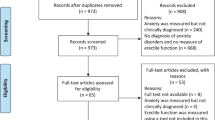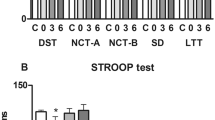Abstract
The aim of this study was to assess the influence of anxiety and plasma catecholamines on the pharmaco-induced erection of psychogenic erectile dysfunction (ED) patients. A total of 23 patients with psychogenic ED aged from 19 to 43 y were submitted to: (1) anxiety evaluation by the Spielberger's State and Trait Anxiety Inventory—STAI; (2) intracavernous injection of PGE1 10 μg+phentolamine 1 mg with the response monitored by Rigiscan; (3) blood sampling from cavernous bodies and cubital vein for adrenaline and noradrenaline levels determination by high performance liquid chromatography. The whole procedure was done in a single clinical setting at the same day. We found no significant correlation between the erection rigidity and the cavernous or peripheral catecholamines or between erection rigidity and anxiety scores. Some patients showed rigid erections despite high anxiety scores or penile catecholamine levels while others, with incomplete erections, had much smaller levels. These results are suggestive of a more complex mechanism controlling the penile sympathetic responsiveness in psychogenic ED patients.
This is a preview of subscription content, access via your institution
Access options
Subscribe to this journal
Receive 8 print issues and online access
$259.00 per year
only $32.38 per issue
Buy this article
- Purchase on Springer Link
- Instant access to full article PDF
Prices may be subject to local taxes which are calculated during checkout



Similar content being viewed by others
References
Pagani E, Puech-Leão P, Glina S, Reis JMSM . The value of a second injection on the pharmaco induced erection test (PIET). Int J Impot Res 1997; 9: 167–168.
Lehmann K et al. Variable response to intracavernous prostaglandin E1 testing for erectile dysfunction. Urology 1999; 3: 539–543.
Kim SC, Oh MMJ . Norepinephrine involvement in response to intracorporeal injection of papaverine in psychogenic impotence. J Urol 1992; 147: 1530–1532.
Granata A, Bancroft J, Del Rio G . Stress and the erectile response to intracavernosal prostaglandin E1 in men with erectile dysfunction. Psychosom Med 1995; 57: 336–344.
Aversa A et al. Anxiety-induced failure in erectile response to intracorporeal prostaglandin-E1 in non-organic male impotence: a new diagnostic approach. Int J Androl 1996; 19: 307–313.
Spielberger CD, Gorsuch RL, Lushere RE . STAI Manual for the State Trait Anxiety Inventory. Consulting Psychologists Press. Palo Alto, CA, USA, 1970.
Spielberger CD, Lushere RE, McAdoo WG . Theory and measurement of anxiety states. In: RB Cattell (ed). Handbook of Modern Personality Theory. Aldene in press; Chicago, USA; 1971.
Kessler WO . Nocturnal penile tumescence. Urol Clin North Am 1988; 15: 81–86.
Lang PJ, Davis M, Ohman A . Fear and anxiety: animal models and human cognitive psychophysiology. J Affect Disord 2000; 61: 137–159.
Goldstein DS . Clinical assessment of sympathetic responses to stress. Ann NY Acad Sci 1995; 771: 570–593.
Van der Borght W, Vandershueren D, Demyttenaere K . The effects of stress and coping upon the diagnostic intracavernous injection in men with erectile dysfunction. J Psychosom Res 1995; 39: 865–873.
McCance AJ . Assessment of sympatoneural activity in clinical research. Life Sci 1991; 48: 713–721.
Eisenhofer G . In vivo kinetics of catecholamines. J Auton Pharmacol 1994; 14: 7–8.
Lue TF et al. Hemodynamics of erection in the monkey. J Urol 1983; 130: 1237.
Lue TF et al. Hemodynamics of canine corpora cavernosa during erection. Urology 1984; 24: 347.
Becker AJ et al. Cavernous and systemic plasma levels of norepinephrine and epinephrine during different penile conditions in healthy men and patients with erectile dysfunction. Urology 2002; 59: 281–286.
Becker AJ et al. Plasma levels of cavernous and systemic norepinephrine and epinephrine in men during different phases of penile erection. J Urol 2000; 164, 573–577.
Dimsdale JE, Young D, Moore R . Do plasma norepinephrine levels reflect behavioral stress? Psychosom Med 1987; 49: 375–382.
Masters WH, Johnson VE . Human Sexual Response. Little, Brown & Co. Boston, USA, 1966.
Diederichs W, Stief CG, Lue TF, Tanagho EA . Norepinephrine involvement in penile detumescence. J Urol 1990; 143, 1264–1266.
Author information
Authors and Affiliations
Corresponding author
Rights and permissions
About this article
Cite this article
Pagani, E., Glina, S., Puech-Leão, P. et al. Anxiety and high plasma catecholamines do not impair pharmaco-induced erection of psychogenic erectile dysfunctional patients. Int J Impot Res 15, 282–286 (2003). https://doi.org/10.1038/sj.ijir.3901002
Received:
Revised:
Accepted:
Published:
Issue Date:
DOI: https://doi.org/10.1038/sj.ijir.3901002
Keywords
This article is cited by
-
Sildenafil citrate significantly improves nocturnal penile erections in sildenafil non-responding patients with psychogenic erectile dysfunction
International Journal of Impotence Research (2004)



